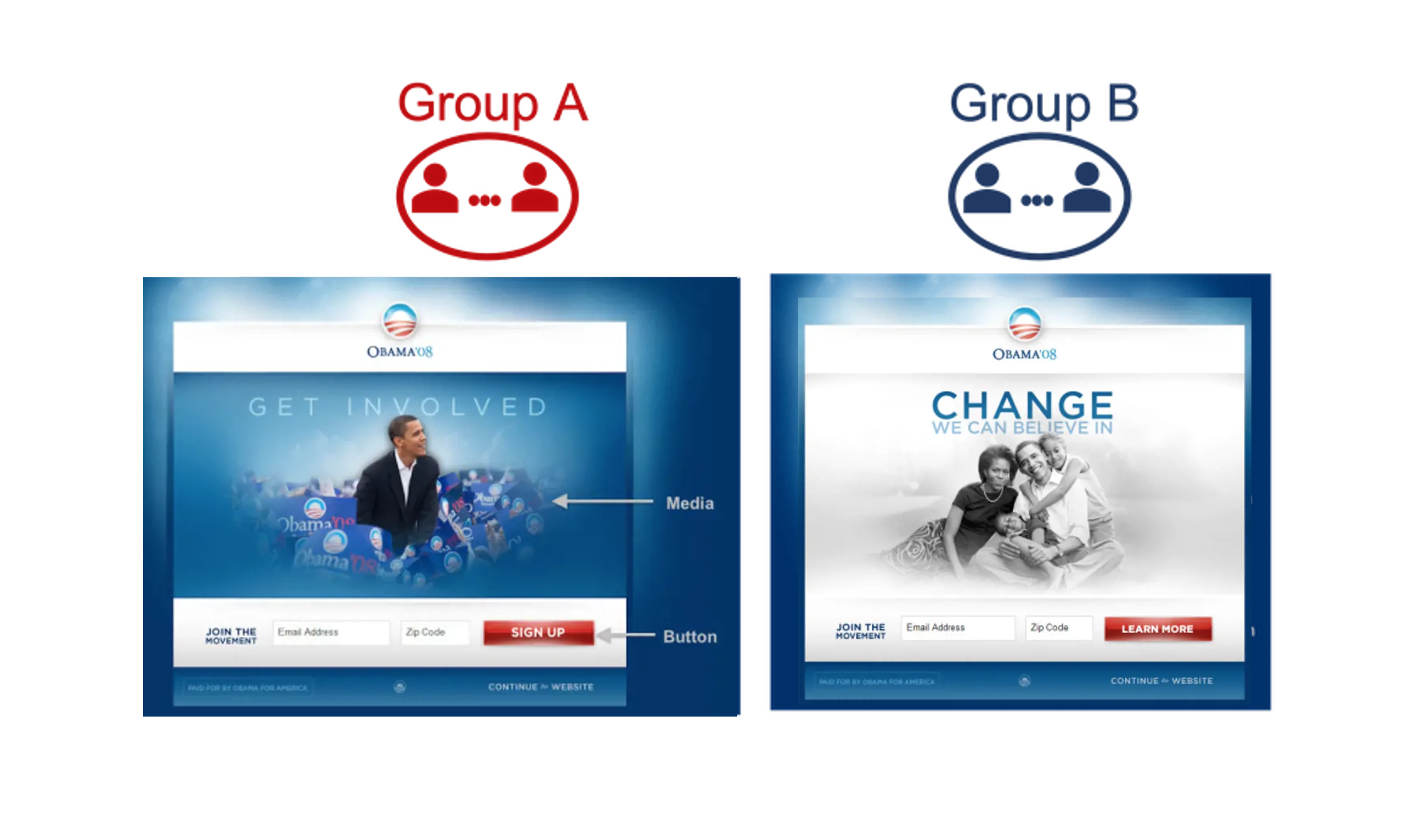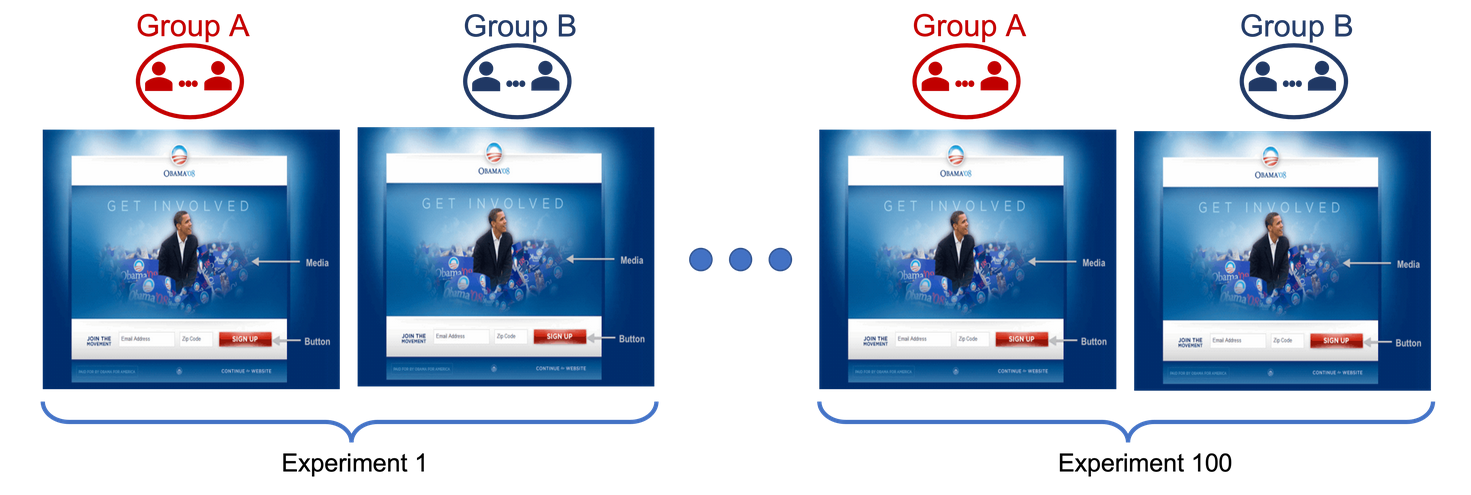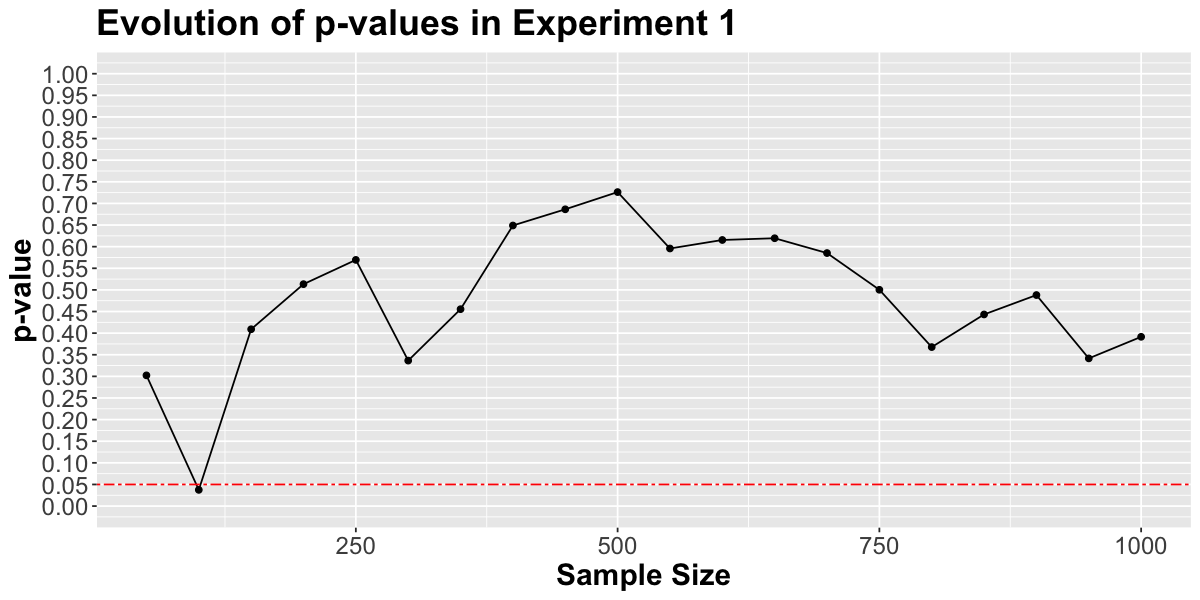A/B Testing
Contents
A/B Testing¶

Photos/Images by Optimizely
Overview¶
This chapter provides an introduction to A/B testing and the early peeking problem. The goal is that you understand the main principles of A/B testing that will allow you to properly design, run, and analyze data from A/B tests. While you probably know the main concepts behind A/B testing, the usage of online platforms to collect, store and analyze data from A/B tests open new challenges. For example, people get tempted to peek at results before the A/B test ended and take actions usually result in false discoveries.
A/B Testing is a technique used to compare two variations of a product or service: control (A) and variation (B)
A/B testing became very popular in the context of updating and improving websites.
It’s main concepts are founded in the context of hypothesis testing and inference to compare population quantities from 2 distributions
for example: comparison of two population means or population proportions
Analysis Design¶
As in any other statistical anlaysis, important steps of an A/B testing experiment include,
post the question(s) you want to answer using data
design the experiment to address your question(s)
identify appropriate methodologies to analyze the data
run the experiment to collect data
analyze the data according to the experimental design and make decisions
Case study¶
Obama’s 60 million dollar experiment¶
In 2008, Obama’s campaign was looking to increase the total amount of donations to the campaign. Organizers run an experiment to compare visitors’ responses to different versions of the website.

A full description of this case study can be found here.
While there is not a unique way to design an A/B testing experiment, randomized controlled experiments are commonly used in practice. When participants are randomly assigned to the experimental group or the control group, you only expect to observe differences driven by the controlled effect (e.g., a new website) and not by other confounding factors.
Other decisions need to be made when designing an A/B testing experiment, including sample size, number of tests, methodology. Since the choices made would influence the results, companies usually run some calibration tests before running the actual experiment.
Example
Question: Does visitors of the new website contribute with larger donations for the political campaign?
Design: Randomly allocate 1000 visitors to each website (control and new)
Method: Analyze the data sequentially in batches of 50 visitors per website. Use a classical \(t\)-test to run the analysis, compute \(p\)-values and confidence intervals
Decision: Stop the experiment if the \(p\)-value of a test drops below a significance level of \(0.05\)
So, what is new about A/B testing?
Early stopping¶
New platforms have been developed to assist companies to analyze, report and visualize the results of their experiments in real time

Figure by D. Meisner in Towards Data Science
These platforms allow the users to continuously monitor the \(p\)-values and confidence intervals in order to re-adjust their experiment dynamically.
Caution
In classical hypothesis testing theory, the sample size must be fixed in advance when the experiment is designed!! Is it ok to peek at results before all the data are collected??
In general, there are large opportunity costs associated with longer experiments. Thus, users may prefer to adaptively determine the sample size of the experiments and make decisions before the planned experiment ends.
Definition
Early stopping refers to ending the experiment earlier than originally designed.
Can we stop or re-design the experiment earlier if we have supporting evidence to do so?? Let’s answer this question using data!
A/A Testing¶
To examine the problem of early stopping, let’s simulate data for which \(H_0\) is true (i.e., there is no effect)
Example
All users are allocated to the same version of a website.

In such a scenario, data from both groups are generated from the same distribution. Thus, we know that rejecting \(H_0\) is a mistake!
Simulation Example
generate 1000 data points per group (control and variation) from the same distribution (total sample size of 2000)
sequentially analyze the data in batches of 50 observations per group using a two-sample \(t\)-tests
sequentially compute and monitor the (raw) \(p\)-values
reject the null hypothesis if a \(p\)-value drops below \(0.05\) and stop the experiment.
Simulating this kind of data and running the same analysis many times allows you examine the properties of the procedure used. For example, you can estimate the type I error rate by counting in how many experiments the \(p\)-value has dropped below the significance level and you erroneously reject the null hypothesis
Wrong Rejection
The data were generated from the same distribution (e.g., all users are allocated to the same version of a website). Thus, in principle, the \(p\)-value should not drop below 0.05. However, due to randomness, you may still find significant differences between the two groups. But how often does that occur??
Let’s start by simulating one such experiments and visualizing the results.
# FUNCTION
# Two-sample t-test with tracking sequential statistic and p-values by incremental sample sizes until getting to n in each group.
# @param n (numeric): Initially planned sample size for each group (for simplicity, n needs to be a multiple of sample_increase_step).
# @param d_0 (numeric): effect size.
# @param mean_current (numeric): Population mean for control variation.
# @param sd_current (numeric): Population standard deviation for current variation.
# @param sd_new (numeric): Population standard deviation for new variation.
# @param sample_increase_step (numeric): Sample size increment.
# @return p.value.df: A tibble that has 3 columns:
# inc_sample_size, statistic, and p_value
incremental_t_test <- function(n, d_0, mean_current, sd_current, sd_new, sample_increase_step) {
sample_current <- rnorm(n, mean = mean_current, sd = sd_current)
sample_new <- rnorm(n, mean = mean_current + d_0, sd = sd_new)
p.value.df <- tibble(
inc_sample_size = rep(0, n / sample_increase_step),
statistic = rep(0, n / sample_increase_step),
p_value = rep(0, n / sample_increase_step)
)
current_sample_size <- sample_increase_step
for (i in 1:nrow(p.value.df))
{
t_test_results <- t.test(sample_new[1:current_sample_size], sample_current[1:current_sample_size],
var.equal = TRUE,
alternative = "greater"
)
p.value.df[i, "statistic"] <- as_tibble(t_test_results$statistic)
p.value.df[i, "p_value"] <- as_tibble(t_test_results$p.value)
p.value.df[i, "inc_sample_size"] <- current_sample_size
current_sample_size <- current_sample_size + sample_increase_step
}
return(p.value.df)
}
#---------------------------------------------------------------
#TEST and PLOT
options(repr.plot.width = 10, repr.plot.height = 5)
options(warn=-1)
set.seed(301)
answer2.1 <-
incremental_t_test(n = 1000, d_0 = 0, sample_increase_step = 50, mean_current = 200, sd_current = 50, sd_new = 50)
sequential_pvalue <-
answer2.1 %>%
ggplot() +
geom_line(aes(x = inc_sample_size, y = p_value)) +
theme(
text = element_text(size = 18),
plot.title = element_text(face = "bold"),
axis.title = element_text(face = "bold")
) +
geom_point(aes(x = inc_sample_size, y = p_value)) +
ggtitle("Evolution of p-values in Experiment 1") +
ylab("p-value") +
xlab("Sample Size") +
geom_hline(
yintercept = 0.05,
colour = "red",
linetype = "twodash"
) +
coord_cartesian(ylim = c(0, 1)) +
scale_y_continuous(breaks = seq(0, 1, by = 0.05))
sequential_pvalue

Interpretation¶
After collecting data from 100 participants the \(p\)-value drops below \(0.05\) so the experiment is stopped. But we know that claiming a significance difference in this experiment is a mistake.
Example
Changing the website is costly and may not really increase the size of the donations as expected
But, isn’t this mistake one potential result of the test?
Definition
In statistical hypothesis testing, rejecting \(H_0\) when it is true is known as the type I error. The probability of a type I error is equal to the significance level of the test.
In our example, the test was planned so that the probability to falsely rejecting \(H_0\) is 5%. So, why is this a problem??
Type I error rate inflation
The problem is that the probability of falsely rejecting \(H_0\) may be larger than expected!
To know if the probability of falsely rejecting \(H_0\) is larger than 5%, we need to run many of these experiments!!
The figure below shows the p-value trajectory of 100 experiments. We see that the p-values of more than 5% of the experiments are below the significance level.

Important
It can be proved, mathematically, that under the null hypothesis, the classical \(p\)-value will always cross \(\alpha\) if the experimenter waits long enough\(^{*}\). This means that with increasing data, the probability of falsely rejecting a true \(H_0\) approaches to 1!
[*] David Siegmund. 1985. Sequential analysis: tests and confidence intervals. Springer.
Summary and key concepts learned¶
A/B testing refers to an experiment, in which users are randomly assigned to one of two variations of a product or service: control (A) and variation (B) to see if variation B should be used for improvement.
The statistic used to test a hypothesis, the sample size calculation, the type I error rate specification and the desired power are all important and interconnected pieces of the experimental design!
In classical hypothesis testing theory, the sample size must be fixed in advance when the experiment is designed!!
Modern platforms allow the users to continuously monitor the p-values and confidence intervals of their tests as data are collected (peeking) in order to re-adjust their experiment dynamically.
Stopping an experiment and rejecting \(H_0\) as soon as the \(p\)-value is below the specified significance level can drastically inflate the type I error rate
Attention
Controlling the risk of wrongly rejecting the null hypothesis is not an easy task in A/B testing if peeking and early stops are allowed!
